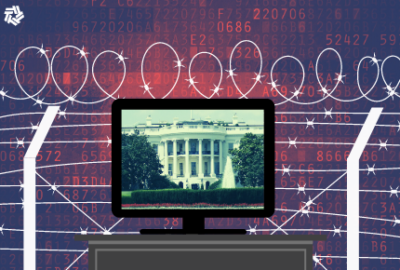Hubbard Radio Washington DC, LLC. All rights reserved. This website is not intended for users located within the European Economic Area.
Exclusive
Money, momentum give new GSA administrator a rare opportunity
Robin Carnahan, the administrator of the General Services Administration, said in her first interview since being confirmed by the Senate that she wants GSA to ...
Best listening experience is on Chrome, Firefox or Safari. Subscribe to Federal Drive’s daily audio interviews on Apple Podcasts or PodcastOne.
It’s a rare time when an agency has money and momentum to pursue true change and innovations. But that is exactly what Robin Carnahan believes she has as the new administrator of the General Services Administration.
In her first interview since being confirmed by the Senate about six weeks ago, Carnahan detailed her initial thinking about how to take advantage of this rare opportunity.

“We have that now to help the government deliver better, and we’re going to make the most of it,” Carnahan said in an exclusive interview with Federal News Network. “GSA is a service delivery agency, and it’s our job to figure out how to deliver that good service for customers and look out for the taxpayers while doing it. I’m also interested in empowering the GSA staff with whatever tools they need to do their best work. There are a number of challenges. I think probably the biggest challenge and opportunity I’ll say is helping partners rethink the future of work and what the workplace is going to look like going forward, and help them reimagine what that could look like in ways that are secure and equitable and inclusive and put customers right at the center of things.”
Federal buildings and office space is the first area where Carnahan pointed to the money and momentum.
The momentum comes from how agencies are rethinking what the federal office will look like as employees return and continue to work in a hybrid environment.
Carnahan said this means helping agencies “right size their footprint,” and developing other offerings like “home office in a box” to help employees work wherever they are.
“Folks are looking about the their footprints and figuring out how to reassess who is teleworking and who’s going to be in the office and what that combination looks like,” she said. “GSA is in the middle of all of those conversations, both within our own agency, but governmentwide too. We’re on the task forces with OMB and OPM looking at these issues.”
Time to rejigger federal office space
Another reason for the momentum is 60% of GSA’s leases for office space are set to expire between fiscal 2019 through 2023 — as of 2018. The agency expected about a third of Washington, D.C., leases to expire between 2019 and 2020. The National Capital Region is part of GSA Region 11, which has the most rentable square footage nationwide.
All of these factors, and several others, are giving GSA momentum to rethink so much about federal real estate.
Many times, agencies have the momentum, but not the money.
Carnahan said the money is there, too, for GSA to pursue real improvements.
“We have lots of priorities when it comes to real estate. One of the major things that we’re focused on is the backlog and maintenance,” she said. “There’s money available in the Federal Buildings Fund and we are talking a lot to our partners on the Hill about how to access that so we can maintain our public buildings in ways that make them safe and attractive for folks to be working in. We also have this consolidation question that is just hanging over everyone’s agency as they rethink the future of work.”
The House passed version of the consolidated spending bill for fiscal 2022 gives GSA more than $8.7 billion through the Federal Buildings Fund to spend on federal building maintenance and repairs.
“I am making the cases as strongly as I can that we are doing a disservice to the public and to taxpayers if we allow our federal building assets to fall into disrepair. It’s as simple as that,” Carnahan said. “We have a backlog of maintenance needs and it is the responsibility of people in public office to make decisions about how to allocate that we know what those needs are. We’re making the case strongly in Congress. I’ll continue to do that.”
Carnahan added that the money and momentum also gives GSA the opportunity to reimagine federal office space more broadly than just the pandemic. She said a team from across the agency is focused on how the open office concept could be “rejiggered a little bit.”
Leaning on her experience at 18F
The second area where the money and momentum are around acquisition and technology.
For these parts of GSA’s mission, the money is coming through things like the Technology Modernization Fund (TMF) and the Federal Citizen Services Fund. Congress allocated $1 billion for the TMF in the American Rescue Plan Act and the House added another $50 million to the TMF in its fiscal 2022 spending bill. In the FCSC, the House approved $59.2 million, which is $4 million more than 2021.
The momentum comes from the excitement created across the government to tap into the TMF as well as GSA’s own improvements over the last several years to address long-standing technology debt in the Federal Acquisition Service.
Carnahan came from that side of GSA where she ran 18F’s state and local consulting practice for four years.
But she also is quick to point out that she isn’t a technologist or an acquisition expert, but someone who has experience managing large organizations, including being the Secretary of State for Missouri.
“I learned a lot of lessons while I was there, about the importance of technology, the importance of procurement, things that you don’t always think about when you think about government service delivery. But it turns out, if you don’t get those, right, you can’t provide effective service to the public,” she said. “What I was able to do at 18F was to dig deeper into those issues on somebody wants to government to work well. It turns out technology and procurement have to get fixed if you’re going to have government work well. That time at 18F helped me understand the scale of the problem.”
She said she worked closely with trained technologists to identify cost effective ways to address the challenges of improving government services. She also spent a lot of time helping non-technical government leaders communicate and translate their policy priorities and objectives into how to effectively implement those through technology and delivery.
“Those are really, really valuable lessons that I am using every day in this job as administrator,” she said. “One of the things we saw through the last year is that you could pass a policy in Washington, but if you can’t implement it, it doesn’t have the same effect for people if they can’t see the result. So that’s why the implementation role that GSA plays and supporting our agency partners and implementing through technology or anything else is so important.”
Carnahan didn’t offer any specific plans or priorities around technology and acquisition. She did say supply chain risk management and current efforts around Section 889 remain a top priority for her as it does for the Biden administration.
Data drives decisions, goals
Her focus is more on improving GSA’s service deliver to its agency and industry partners.
“My goal here is to make sure that is as good as it can be as an experience for customers, and our business partners and industry partners. In fact, I’ve said a bunch to the team, that what I’d really like is for anybody who’s interacting with GSA, whether it’s walking in a building online, on the phone, wherever it is to say, ‘Wow, that was a great experience. I wish everything in government could work that well.’ That is my goal here,” Carnahan said. “I know that in order to achieve that we’ve got a lot of work to do. We’ve got to keep talking to customers. We’ve got to talk to industry partners. We need to understand how we’re doing now and how we can integrate their feedback and keep improving. The bottom line is I want to make it as easy as possible for our agency partners to buy and access what they need good services, workspace technology through GSA, and I want to make it as easy as possible for our industry partners, especially small businesses, to sell through GSA. That’s my bottom line.”
She also said these decisions for how to apply the money to meet the momentum will be based on data.
“I’m very interested in feedback from both customers and our, our industry partners, we’ve got to have both sides of those customers. We’ve got to get it right. I tend to be very data driven, and results and impact driven. You can only get that if you have both sides of that equation that are at the table and trying to figure out how to get the best results,” Carnahan said. “My expectations for GSA are to be a place for great customer service and an empowered workforce that is able to do their best work. Those are the two things I’m going to be focused on. And I’m going to talk about over and over again till people get sick of it.”
Copyright © 2024 Federal News Network. All rights reserved. This website is not intended for users located within the European Economic Area.
Jason Miller
Jason Miller is executive editor of Federal News Network and directs news coverage on the people, policy and programs of the federal government.
Follow @jmillerWFED






